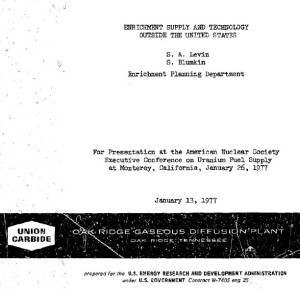Iran Owned Part of Eurodif – Document Posted
By Ivanka Barzashka
FAS has posted a report on “Enrichment Supply and Technology Outside the United States” by S. A. Levin and S. Blumkin from the Enrichment Department of the Oak Ridge Gaseous Diffusion Plant, operated at the time by Union Carbide. The document, prepared for the U.S. Energy Research and Development Administration, reviews international uranium enrichment capacity and isotope separation technology as of 1977.
Apart from being of historical interest, the report explicitly states that Eurodif, a French-organized multinational enrichment consortium, was in part owned by Iran.
“The membership and apportionment of shares in Eurodif has been changeable. Presently, it is constituted by Belgium and Spain 11% each. Italy 25%, France 28% and Sofidif 25%, which is 40% owned by Iran and 60% by France.”
“In 1975, another consortium called Coredif with the same multinational membership as Eurodif but a different distribution of shares (Eurodif 51%, France 29% and Iran 20%) was organized to assess future nuclear demand and build a second Eurodif-type plant if the study results justified it.”
This is consistent with Iran’s claims that it owned shares of the enrichment company prior to the Islamic Revolution in 1979. This claim has been confirmed by the French government, but Iran has never received enriched uranium from the company.
The document has a disclaimer that “[i]t should not be presumed that the inclusion in this presentation of any reported information necessarily attests to its validity.”
Satellite imagery has long served as a tool for observing on-the-ground activity worldwide, and offers especially valuable insights into the operation, development, and physical features related to nuclear technology.
This report outlines a framework relying on “Cooperative Technical Means” for effective arms control verification based on remote sensing, avoiding on-site inspections but maintaining a level of transparency that allows for immediate detection of changes in nuclear posture or a significant build-up above agreed limits.
The grant comes from the Carnegie Corporation of New York (CCNY) to investigate, alongside The British American Security Information Council (BASIC), the associated impact on nuclear stability.
Satellite imagery of RAF Lakenheath reveals new construction of a security perimeter around ten protective aircraft shelters in the designated nuclear area, the latest measure in a series of upgrades as the base prepares for the ability to store U.S. nuclear weapons.
